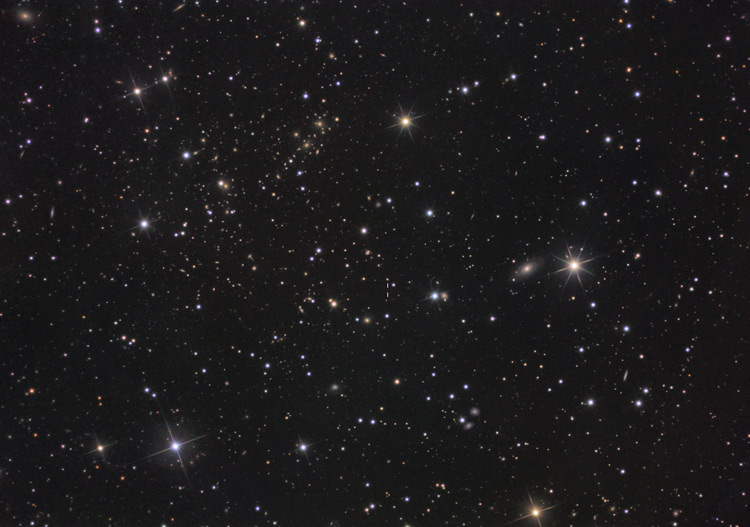Credit & Copyright: Johannes Schedler
(Panther Observatory)
Additional Image Data: Ken Crawford (Rancho Del Sol Observatory)
Explanation:
Spiky stars are nearby, but
fuzzy galaxies are strewn far across
the Universe in this cosmic view.
Spanning about 1/2 degree on the sky,
the pretty picture is the result of astronomer Johannes
Schedler's project to look back in time,
toward a quasar 12.7
billion light-years away.
The quasar is just visible in the
full resolution image at the
position marked by short vertical lines (center).
The intrinsically bright nucleus of a young,
active galaxy powered by a supermassive black hole, the quasar
was recently identified
as one of the most distant
objects known.
Since
light
travels at a finite speed, the
galaxies receding into the distance are seen as they
were in the increasingly remote past.
The quasar appears as it did about 12.7 billion years ago,
when the Universe was just 7 percent of its
present age.
Of course,
the
expansion of the Universe
has redshifted the light.
Schedler added image data extending to the near-infrared,
acquired by collaborator Ken Crawford,
to detect the distant quasar, with a measured
redshift of 6.04.
Additional Image Data: Ken Crawford (Rancho Del Sol Observatory)
1999 2000 2001 2002 2003 2004 2005 2006 2007 2008 2009 2010 2011 2012 2013 2014 2015 2016 2017 2018 2019 2020 2021 2022 2023 2024 2025 |
Yanvar' Fevral' Mart Aprel' Mai Iyun' Iyul' Avgust Sentyabr' Oktyabr' Noyabr' Dekabr' |
NASA Web Site Statements, Warnings, and Disclaimers
NASA Official: Jay Norris. Specific rights apply.
A service of: LHEA at NASA / GSFC
& Michigan Tech. U.
|
Publikacii s klyuchevymi slovami:
quasar - redshift - kvazary - krasnoe smeshenie
Publikacii so slovami: quasar - redshift - kvazary - krasnoe smeshenie | |
Sm. takzhe:
Vse publikacii na tu zhe temu >> | |
